
(This essay is meant to continue from ideas expressed here.)
What are birthdays on the other side? It is the death day which is the real birthday.
- Sir Arthur Conan Doyle
I’m trying to tell you this is an all bets are off sort of thing. We may be opening a black box that may scrap our whole picture of space/time, might even have a link to another universe.
– Dr. Edward Jessup in Altered States.
And if I have to tell you how Altered States fits into all this, you’re on the wrong fan page.
The lines above have obvious relevance to Peter’s current predicament, of course, but they also make me wonder if the Schrodinger’s box he’s created is just a larger, more-inclusive version of Walter’s isolation tank, which is to say a magical, transformative space in which minds can meld, identities can swap, and time can be made plastic. The qualities of this multi-dimensional “bridge” promise to be responsible for a lot of the mystery and revelation coming our way this year.
Since I still put a great deal of stock in the idea of Peter as the show’s metaphorical Harry Houdini (see here), the box is also a magic trick, a “death-defying ecsape!” Peter has, in the spirit of the great escape artists, disappeared inside a box with seemingly no possible way to escape. The audience (that’s you and me) knows he will escape, of course, but it doesn’t make the trick any less astonishing for that.
Hewat Mackenzie reported on witnessing one such trick in his book Spirit Intercourse (italics mine):
"From the time (Houdini) entered it to the time that he (escaped), only one and a half minutes had elapsed."
And, of course, the very term black box has a specific meaning in science:
Almost anything might be referred to as a black box: a transistor, an algorithm, or the human mind.
- Wikipedia
The box is also a nifty little metaphor for something that’s at the heart of J.J. Abrams’s style of storytelling. For those not familiar with the story, it involves a trip made to a magic shop (!) when he was a boy:
He recalled getting something called a mystery box. On the outside it had a big question mark, and on the inside it had . . . what? Toys, presumably. Tricks, maybe. If you shook the box, you heard them rattling around. But their precise nature wasn’t known. That was the thrilling part, the part that held your imagination captive. You purchased a mystery box because you wanted to be surprised.
“What are stories…but mystery boxes?…The first act is called the teaser.” Then he broadened the metaphor. “What’s a bigger mystery box than a movie theater? You go to the theater, you’re just so excited to see anything — the moment the lights go down is often the best part.” He explained that he was going on about all of this because he had come to realize, “Oh, my God, mystery boxes are everywhere in what I do.”
That presentation was four years ago, but it is still mentioned constantly by Abrams’s closest friends and collaborators, who call his mystery-box riff the best distillation of what makes him tick as a writer, director and producer of movies and television shows.
“Filmmaker J. J. Abrams Is a Crowd Teaser,” by Frank Bruni.
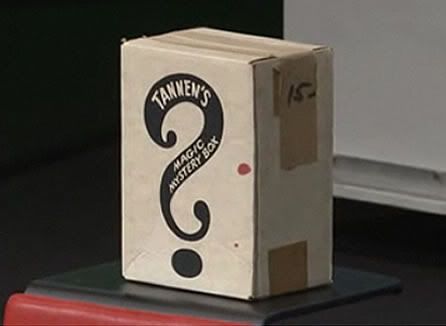
So what we have here, possibly, is the greatest metaphorical expression yet of Abrams’s fascination with the Mystery Box, a box (famously pictured on the cover of the issue of Wired that Abrams edited) we assume is filled with the sort of magic tricks that would fascinate a young boy. Like a Schrodinger box, we really can’t know what’s in it until we look. Abrams steadfastly refuses to open it, though, preferring to enjoy the infinite possibilities of what might be inside it.
For some time now I’ve thought that J.J. Abrams is more interested in recreating something than making something that’s brand new. This isn’t to take away any powers of originality from him, but I think he enjoys remaking something and placing it in a newer or different context to see what the juxtaposition might yield. For instance, Cloverfield is basically a remake of the 1953 film The Beast From 20,000 Fathoms and the excitement of it lies in the reinterpretation of it for a post 9/11 audience.
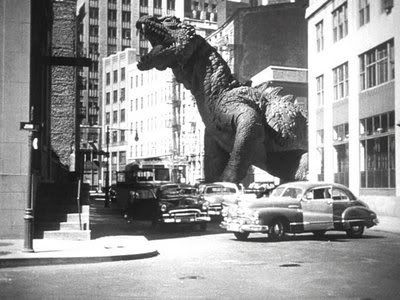
Fathoms was probably corny in 1953, I imagine, but Cloverfield is genuinely frightening, thanks to its ersatz reality-cam and special effects. But at its pulpy, sci-fi heart, it’s no different than Beast. There’s even a sly nod to the original feature’s climactic showdown at Coney Island.
So might there be some older television program that FRINGE might be similarly related to, a program that Abrams might have had in mind when conceiving the project? Something to be updated for the 21st century while retaining its essential qualities?
Oh, I think so and you may already be way ahead of me. But we’ll talk about it next time when we can go into the subject in depth. There’s one other show, however, that I think we’re meant to recall (although most of FRINGE’s audience may barely be aware of it) when Peter disappears, and we can’t move on until we touch on it.
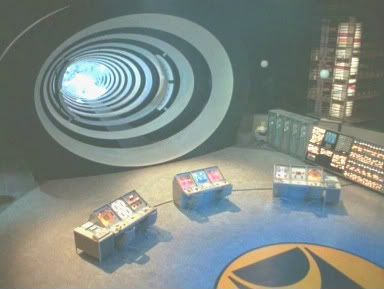
The Time Tunnel (1966-1967) was a sci-fi series whose pilot episode introduced us to Project Tic Toc, a secret government agency devoted to creating the means to travel through time. However, when the powers that be decide to pull the plug for financial reasons, well, the spirit of scientific inquiry wins the day:
When no one else was around to observe, a key Time Tunnel scientist, young physicist Dr. Anthony Newman turns the machine on and sends himself back in time in an attempt to prove that the Time Tunnel project funds were not wasted. In so doing, Newman becomes "lost in time". The Time Tunnel top personnel quickly return, to see through the Tunnel that Newman is aboard the soon-to-sink Titanic. They can also see that he cannot escape before the sinking, and they cannot retrieve him…In an attempt to rescue his younger friend, another key Tic Toc scientist, Dr. Douglas Phillips, enters the Time Tunnel as well, carrying a newspaper describing the sinking to occur.
- Wikipedia
And so it went from week to week, as the two scientists (ably played by James Darren and Robert Colbert) would wander from one notable historical event to the next (the timestream somehow never saw fit to deposit them at a point when nothing famous or newsworthy happened!), while their friends back at the base would attempt to extract them from their temporal abyss and bring them back home. They were never successful, of course, and the show’s last episode deposited them neatly back on the Titanic, creating a time loop that would carry them through countless reruns.
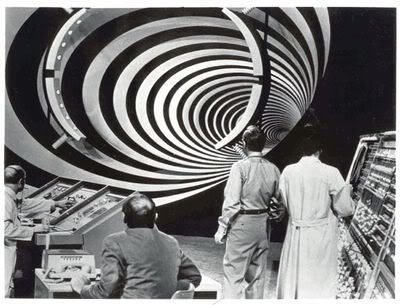
Now it isn’t just the idea of someone becoming unstuck in time that’s relevant here, but as soon as Peter created “the bridge,” I was struck by the similarity between the base that had just been created and the base from The Time Tunnel: a bunch of desks flanked by gimcrack computers, all facing a massive piece of time travel machinery. It certainly felt like an homage. Here’s the official symbol for Project Tic Toc (meant to convey the shape of an hourglass):
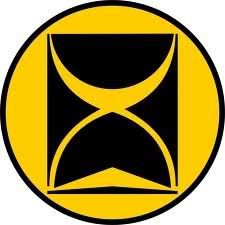
Here’s the one for the future Fringe Division:
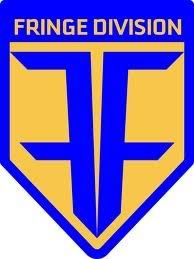
Now turn the Project Tic Toc one on its side:
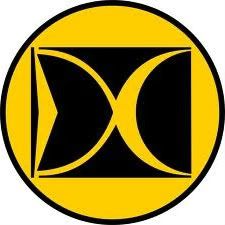
(Too much of a reach? Maybe. I do know that I think the Fringe Division symbols are starting to look increasingly militaristic to me.)
Did it mean that we were going to see Peter at Pearl Harbor or the Battle of Bull Run? Of course not, but it did hint that he might somehow be lost in time in a way that had yet to be revealed. The real clues to that, I felt, were lurking in the shadows of the 1960’s sci-fi show that FRINGE had really been modeled after. It was the show that provided the plot of a man who had never existed, and so many others. It’s the show that has me wondering this:
What if someone created a synthetic being named Peter Bishop for the express purpose of making both universes work together?
I think it’s a show whose plots contain a lot of hints as to what is going on. Part of its name comes from last week’s glyph word, in fact.
It’s a show whose name actually means the exact same thing as FRINGE.
More next time.
If a monument were to be built in America as a memorial to…independence, I should think it very natural if it were built by united effort, if it were a common work of both nations.
- Édouard René de Laboulaye, at a dinner during which the first discussions that would result in the Statue of Liberty took place.













3 Comments:
Excellent article! Lots of food for thought.
Peter's exile represents a black box of infinite - through time & space - story possibilities. Of which we will probably only be made privy to a very limited number.
Those Time Tunnel pictures sure bring back a lot of nostalgia. A form of time travel itself!
Thanks and look forward to future articles.
You know what else looks like the Project Tic Toc symbol? The First People machine in Fringe.
You're, um....absolutely right! How very interesting...
Has anyone offered a reason for Peter's burning eyes in the drawing, by the way? I've not seen any comments, I don't think. Do we take it as an ability to see into the future?
Post a Comment
Formatting Key:
- <b>bold</b> = bold
- <i >italic</i> = italic
- <a href="http://fringetelevision.com/">link</a> = link
Anonymous posting has been turned off.